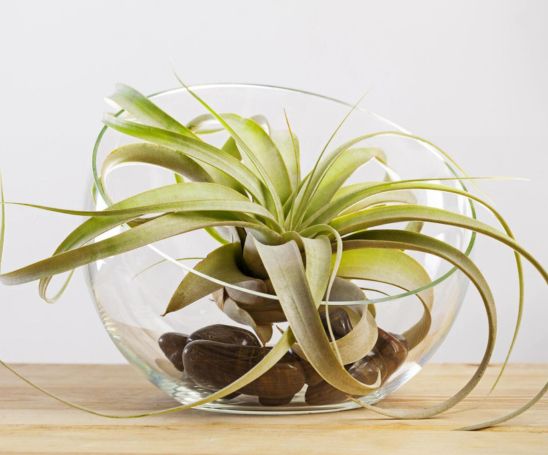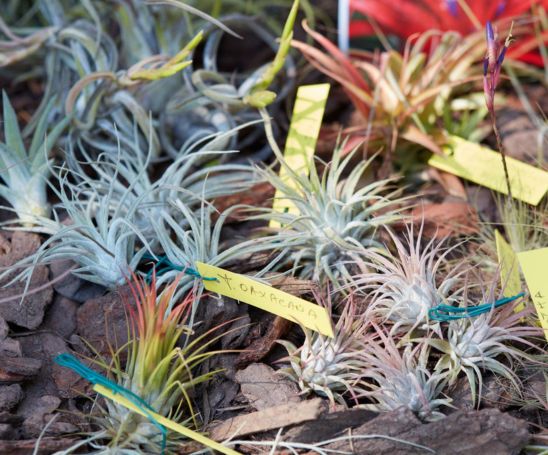How To care for air plants, ensure they receive bright, indirect sunlight and weekly watering. Mist them in between soakings to maintain humidity.
Air plants, known as Tillandsia, have become a favorite among indoor gardening enthusiasts due to their minimal root systems and lack of soil requirements. These unique plants absorb water and nutrients through their leaves, making their care different from that of traditional potted plants.
Thriving on the airy perches of branches or mounted on distinctive displays, they bring a touch of greenery to any space.
How To Take Care Of Air Plants

Caring for air plants (Tillandsia) is straightforward, and their unique ability to thrive without soil makes them a fascinating addition to your indoor plant collection. Here are some tips on how to take care of air plants:
Air Plant Light Requirements
Air plants bask in bright, indirect sunlight. A north or south-facing window offers the perfect amount of luminance. For indoor areas with low natural light, a full-spectrum artificial light can mimic sunbeams. Placing your Tillandsia under these lights for 12-14 hours a day will meet their light requirements.
How Often Should You Water Air Plants?
Air plants, or Tillandsias, should generally be watered once per week, with 2-3 times per week recommended for optimal care. Every 2-3 weeks, it is recommended to soak for two hours. The frequency of watering can depend on the specific conditions in which the plants are grown. For instance, in a drier, hotter climate, more frequent watering or misting may be needed.
The watering process involves submerging the air plant in room-temperature water for about 30 to 60 minutes. After soaking, shake off excess moisture. If your plants need an in-between watering, misting them with a spray bottle is a great method.
Temperature And Humidity
Resilient in nature, air plants persist across a variety of climates. The ideal temperature ranges between 50 to 90 degrees Fahrenheit. Humidity contributes to the air plant’s well-being—aim for 50% relative humidity or higher. Bathrooms with a shower or kitchens are often ideal spots, enriching the air with life-giving moisture.
How To Fertilize Air Plants?
Entice growth and blooming by fertilizing once a month with a balanced, liquid fertilizer diluted to 1/4 strength. Use a fertilizer formulated for air plants. Mist onto the leaves during the regular watering routine, steering clear from over-fertilization, which can harm the plant.
Do Air Plants Need Soil?
Defying conventional gardening, air plants do not need soil to thrive. They draw nutrients from their surrounding air and moisture. This unique attribute lends to a wide array of display options, unconfined by pots or planters filled with soil.
Displaying Your Air Plant
Present your air plants in a manner that encapsulates creativity and functionality. Mount them on driftwood, suspend them in glass terrariums, or seat them atop a coil of copper for an enchanting aesthetic. Remember to choose a location with adequate air circulation, which is crucial for the plant’s well-being.
How To Propagate Air Plants?
Propagation is attained with ease in air plants. Offspring, or ‘pups,’ emerge at their base post-flowering. Once these pups reach one-third the size of the parent plant, pull them apart or use scissors to separate them. This process promises a perpetuation of your air plant collection, gifting you with even more of these delightful entities.
Types Of Air Plants

An exotic array of air plants can elevate the aesthetics of any indoor space. These hardy plants, known as Tillandsia, offer a unique twist on traditional houseplants as they need no soil to grow. Understanding the diverse types of air plants can enrich your cultivational experience, ensuring each species thrives. From vibrant blooms to intriguing shapes, each variety of Tillandsia showcases its remarkable features.
Pink Quill Plant (t. Cyanea)
The Pink Quill Plant, or Tillandsia is a popular choice known for its striking pink flower spathes. This epiphytic perennial makes a striking impression with its bright plumes and easy-care nature.
- Light: Bright, indirect sunlight
- Water: Mist lightly weekly
- Flowering: Vivid pink quills that bloom purple flowers
Xerographica Tillandsias
Regarded as the king of Tillandsias, Xerographica is revered for its silvery-green, wide leaves that form a stunning rosette. Its large size makes it a visual centerpiece in any collection.
- Light: Bright, filtered light
- Water: Soak every one to two weeks
- Uniqueness: Rosette can span over 3 feet in mature plants
Tillandsia Funckiana
The Tillandsia Funckiana stands out with its quirky, elongated shape and tendency to grow in a fascinating zigzag pattern. Its fiery orange blooms add a burst of color against its deep green foliage.
- Light: Full to partial sun
- Water: Frequent misting
- Blooming: Vibrant orange flowers
Flocking Tillandsia
Flocking Tillandsias are unique for their velvety leaves coated with trichomes, giving them a fuzzy appearance. These small but hardy plants enjoy clumping together, creating a “flock” of Tillandsias.
- Light: Moderate to bright indirect light
- Water: Mist twice a week
- Feature: Dense, velvety trichomes on leaves
Tillandsia Harrisii
The Tillandsia Harrisii, with its silvery leaves and robust nature, is a favorite among enthusiasts. This species is lauded for its impressive resilience and its ability to flourish with minimal care.
- Light: Bright, indirect sunlight
- Water: Weekly misting or quick soaks
- Texture: Thick, silver-leaved foliage
Tillandsia Caput Medusae
Embodying the essence of mythical beauty, the Tillandsia Caput Medusae boasts serpentine leaves that resemble the hair of Medusa. This species is distinguished by its twisty leaves and ease of care.
- Light: Bright, indirect, or filtered light
- Water: Regular misting and occasional soaking
- Aesthetic: Snake-like, curvy foliage
Common Problems With Air Plants
Air plants (Tillandsia) are remarkable flora that boast the ability to grow without soil, making them a unique and easy-to-care-for addition to any indoor garden. Despite their resilience, air plants can encounter problems that may hinder their health and aesthetic appeal. Understanding the common issues they may face is key to ensuring your air plants thrive in their environment. Let’s look at some of the typical setbacks these soil-free spectacles encounter and learn how to combat them.
Browning Tips
Browning tips on air plants are a telltale sign that something in their environment is not quite right. Here are potential causes and solutions for this problem:
- Underwatering: Air plants need regular misting or soaking. Increase the frequency to keep them hydrated.
- Dry Air: Ambient humidity plays a crucial role. Consider placing a humidifier nearby or moving the plants to a more humid space like a bathroom.
- Sunburn: Excessive direct sunlight can scorch the tips. Shift your plants to an area with bright, indirect light instead.
- Fertilizer Burn: If you’re fertilizing, ensure it’s balanced and appropriate for air plants. Dilute it more or reduce usage.
Mushy Stems
Mushy stems in air plants often show overwatering or poor ventilation. Unlike the occasional browning tips, a mushy stem is a serious alert that action is needed immediately to save the plant. Follow these steps to address this issue:
- Remove your plant from its current environment.
- Gently shake off excess water and inspect the base.
- Trim away any dead or overly soft portions of the stem.
- Place the plant in a space with ample air circulation to dry.
- Avoid watering until the plant has fully dried and recovered.
Benefits Of Caring For Air Plants
Air plants (Tillandsia) stand out in the plant world for their unique ability to grow without soil, opening up a myriad of creative display options. Not only do they bring a sleek, minimalist aesthetic to any space, but they also offer a range of benefits that extend beyond their visual appeal.
- Enhanced Air Quality: Like other houseplants, air plants can contribute to better indoor air by absorbing carbon dioxide and releasing oxygen. They’re natural air purifiers, helping to filter out airborne contaminants.
- Low Maintenance: These robust plants need minimal care, making them ideal for busy individuals or those new to plant caretaking. They need no soil, periodic watering, and occasional fertilization.
- Stress Reduction: The presence of greenery, including air plants, has been shown to lower stress levels and enhance well-being. Their care can be a calming, therapeutic activity.
- Space Flexibility: Their size and soil-less nature allow for placement in any area of a home or office. Magnetic containers, glass globes, or setting them on a shelf are all viable options.
- Decorative Versatility: Air plants come in an impressive variety of shapes, sizes, and colors, offering endless decorating possibilities for a personalized touch to any setting.
How To Choose The Best Air Plant?
Selecting the perfect air plant involves understanding a few key aspects of these unique organisms. Below is a straightforward guide to ensure you bring home a thriving Tillandsia.
| Aspect | Consideration |
| Variety | Research different species to find one that complements your living environment and aesthetic preferences. Some species may require more light or frequent watering than others. |
| Size and Shape | Consider how much space you have available. Determine whether a larger or smaller plant or one of a specific shape, would best suit your display area |
| Color | Colors can range from green to silver, and even red or purple. Taking note of blooming patterns and colors can help decide which plant will provide the desired visual impact. |
| Health | Inspect the air plant for brown or soft spots which could indicate rot or damage. Healthy plants should have firm, vibrant leaves. |
| Source | Choose a reputable nursery or supplier to ensure you receive quality, sustainably sourced plants. |
FAQs
How To Care For Air Plants Outside?
Outdoor air plant care involves protecting them from harsh elements. Place the plants where they will receive dappled sunlight and ensure they are secure in windy conditions. During cold snaps or extreme heat, increase watering frequency and bring them indoors.
How Big Can Air Plants Grow?
Air plants vary in size, ranging from a couple of inches to several feet in their natural habitats. In-home settings, and they grow to a size compatible with their environment. Some species, like the Tillandsia xerographica, can span up to 3 feet across under optimal conditions.
How Do You Keep Air Plants Alive?
To keep air plants alive, provide bright, indirect sunlight and water by misting several times a week or soaking for 30 minutes weekly. Ensure good air circulation and use well-draining containers to prevent rot. Avoid extreme temperatures for optimal growth.
How Do You Take Care Of Air Plants For Beginners?
Provide bright, indirect sunlight for your air plants. Soak them in water for 20-30 minutes weekly. Allow them to dry completely after soaking. Maintain good air circulation around them. Fertilize monthly with a fertilizer.
Where Do You Put Air Plants?
Place air plants in bright, indirect sunlight on shelves, in terrariums, or mounted on driftwood. Ensure good air circulation and avoid soaking them for extended periods. Keep them away from direct AC or heater drafts.
Conclusion
Caring for air plants is a delightful try. Embrace their uniqueness and revel in their low-maintenance charm. By following the simple tips provided, you’ll ensure your tillandsias thrive. Proper hydration, lighting, and airflow are key. Happy gardening, and watch your air plants flourish!
You may also like How to hang plants from the ceiling without drilling.







